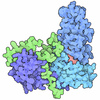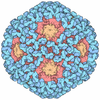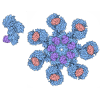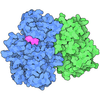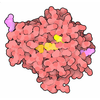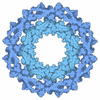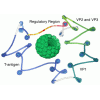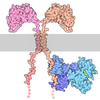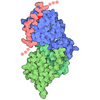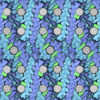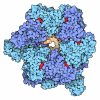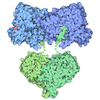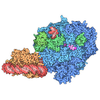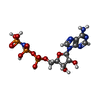[English] 日本語
 Yorodumi
Yorodumi- PDB-8oxo: ATM(Q2971A) dimeric C-terminal region activated by oxidative stre... -
+ Open data
Open data
- Basic information
Basic information
| Entry | Database: PDB / ID: 8oxo | ||||||||||||
|---|---|---|---|---|---|---|---|---|---|---|---|---|---|
| Title | ATM(Q2971A) dimeric C-terminal region activated by oxidative stress in complex with Mg AMP-PNP and p53 peptide | ||||||||||||
 Components Components |
| ||||||||||||
 Keywords Keywords | SIGNALING PROTEIN / Kinase / Ataxia-Telangiectasia Mutated / ATM / p53 | ||||||||||||
| Function / homology |  Function and homology information Function and homology informationestablishment of RNA localization to telomere / positive regulation of telomerase catalytic core complex assembly / cellular response to nitrosative stress / negative regulation of telomere capping / Sensing of DNA Double Strand Breaks / establishment of protein-containing complex localization to telomere / peptidyl-serine autophosphorylation / positive regulation of telomere maintenance via telomere lengthening / pre-B cell allelic exclusion / meiotic telomere clustering ...establishment of RNA localization to telomere / positive regulation of telomerase catalytic core complex assembly / cellular response to nitrosative stress / negative regulation of telomere capping / Sensing of DNA Double Strand Breaks / establishment of protein-containing complex localization to telomere / peptidyl-serine autophosphorylation / positive regulation of telomere maintenance via telomere lengthening / pre-B cell allelic exclusion / meiotic telomere clustering / DNA-dependent protein kinase activity / male meiotic nuclear division / extrinsic component of synaptic vesicle membrane / histone H2AXS139 kinase activity / histone mRNA catabolic process / regulation of telomere maintenance via telomerase / female meiotic nuclear division / lipoprotein catabolic process / DNA double-strand break processing / regulation of autophagosome assembly / cellular response to X-ray / V(D)J recombination / pexophagy / oocyte development / Impaired BRCA2 binding to PALB2 / negative regulation of helicase activity / Loss of function of TP53 in cancer due to loss of tetramerization ability / Regulation of TP53 Expression / signal transduction by p53 class mediator / negative regulation of G1 to G0 transition / negative regulation of glucose catabolic process to lactate via pyruvate / Transcriptional activation of cell cycle inhibitor p21 / regulation of intrinsic apoptotic signaling pathway by p53 class mediator / negative regulation of pentose-phosphate shunt / ATP-dependent DNA/DNA annealing activity / Activation of NOXA and translocation to mitochondria / regulation of cell cycle G2/M phase transition / oligodendrocyte apoptotic process / negative regulation of miRNA processing / intrinsic apoptotic signaling pathway in response to hypoxia / regulation of fibroblast apoptotic process / positive regulation of thymocyte apoptotic process / oxidative stress-induced premature senescence / regulation of tissue remodeling / positive regulation of mitochondrial membrane permeability / mRNA transcription / bone marrow development / positive regulation of programmed necrotic cell death / DNA repair complex / circadian behavior / T cell proliferation involved in immune response / regulation of mitochondrial membrane permeability involved in apoptotic process / germ cell nucleus / reciprocal meiotic recombination / positive regulation of DNA damage response, signal transduction by p53 class mediator / RUNX3 regulates CDKN1A transcription / homolactic fermentation / TP53 Regulates Transcription of Death Receptors and Ligands / Activation of PUMA and translocation to mitochondria / TP53 regulates transcription of additional cell cycle genes whose exact role in the p53 pathway remain uncertain / histone deacetylase regulator activity / regulation of DNA damage response, signal transduction by p53 class mediator / negative regulation of glial cell proliferation / Regulation of TP53 Activity through Association with Co-factors / Homologous DNA Pairing and Strand Exchange / Defective homologous recombination repair (HRR) due to BRCA1 loss of function / Defective HDR through Homologous Recombination Repair (HRR) due to PALB2 loss of BRCA1 binding function / Defective HDR through Homologous Recombination Repair (HRR) due to PALB2 loss of BRCA2/RAD51/RAD51C binding function / Resolution of D-loop Structures through Synthesis-Dependent Strand Annealing (SDSA) / negative regulation of neuroblast proliferation / 1-phosphatidylinositol-3-kinase activity / Resolution of D-loop Structures through Holliday Junction Intermediates / mitochondrial DNA repair / T cell lineage commitment / HDR through Single Strand Annealing (SSA) / Formation of Senescence-Associated Heterochromatin Foci (SAHF) / ER overload response / response to ionizing radiation / negative regulation of B cell proliferation / thymocyte apoptotic process / B cell lineage commitment / TP53 Regulates Transcription of Caspase Activators and Caspases / cellular response to stress / entrainment of circadian clock by photoperiod / mitotic spindle assembly checkpoint signaling / cardiac septum morphogenesis / positive regulation of double-strand break repair / Impaired BRCA2 binding to RAD51 / negative regulation of mitophagy / negative regulation of DNA replication / Zygotic genome activation (ZGA) / positive regulation of release of cytochrome c from mitochondria / mitotic G2 DNA damage checkpoint signaling / PI5P Regulates TP53 Acetylation / Association of TriC/CCT with target proteins during biosynthesis / necroptotic process / TP53 Regulates Transcription of Genes Involved in Cytochrome C Release / negative regulation of telomere maintenance via telomerase / TFIID-class transcription factor complex binding / peroxisomal matrix Similarity search - Function | ||||||||||||
| Biological species |  Homo sapiens (human) Homo sapiens (human) | ||||||||||||
| Method | ELECTRON MICROSCOPY / single particle reconstruction / cryo EM / Resolution: 3 Å | ||||||||||||
 Authors Authors | Howes, A.C. / Perisic, O. / Williams, R.L. | ||||||||||||
| Funding support |  United Kingdom, 3items United Kingdom, 3items
| ||||||||||||
 Citation Citation |  Journal: Sci Adv / Year: 2023 Journal: Sci Adv / Year: 2023Title: Structural insights into the activation of ataxia-telangiectasia mutated by oxidative stress. Authors: Anna C Howes / Olga Perisic / Roger L Williams /  Abstract: Ataxia-telangiectasia mutated (ATM) is a master kinase regulating DNA damage response that is activated by DNA double-strand breaks. However, ATM is also directly activated by reactive oxygen ...Ataxia-telangiectasia mutated (ATM) is a master kinase regulating DNA damage response that is activated by DNA double-strand breaks. However, ATM is also directly activated by reactive oxygen species, but how oxidative activation is achieved remains unknown. We determined the cryo-EM structure of an HO-activated ATM and showed that under oxidizing conditions, ATM formed an intramolecular disulfide bridge between two protomers that are rotated relative to each other when compared to the basal state. This rotation is accompanied by release of the substrate-blocking PRD region and twisting of the N-lobe relative to the C-lobe, which greatly optimizes catalysis. This active site remodeling enabled us to capture a substrate (p53) bound to the enzyme. This provides the first structural insights into how ATM is activated during oxidative stress. | ||||||||||||
| History |
|
- Structure visualization
Structure visualization
| Structure viewer | Molecule:  Molmil Molmil Jmol/JSmol Jmol/JSmol |
|---|
- Downloads & links
Downloads & links
- Download
Download
| PDBx/mmCIF format |  8oxo.cif.gz 8oxo.cif.gz | 809.1 KB | Display |  PDBx/mmCIF format PDBx/mmCIF format |
|---|---|---|---|---|
| PDB format |  pdb8oxo.ent.gz pdb8oxo.ent.gz | 497.3 KB | Display |  PDB format PDB format |
| PDBx/mmJSON format |  8oxo.json.gz 8oxo.json.gz | Tree view |  PDBx/mmJSON format PDBx/mmJSON format | |
| Others |  Other downloads Other downloads |
-Validation report
| Summary document |  8oxo_validation.pdf.gz 8oxo_validation.pdf.gz | 1.8 MB | Display |  wwPDB validaton report wwPDB validaton report |
|---|---|---|---|---|
| Full document |  8oxo_full_validation.pdf.gz 8oxo_full_validation.pdf.gz | 1.8 MB | Display | |
| Data in XML |  8oxo_validation.xml.gz 8oxo_validation.xml.gz | 90.9 KB | Display | |
| Data in CIF |  8oxo_validation.cif.gz 8oxo_validation.cif.gz | 135.8 KB | Display | |
| Arichive directory |  https://data.pdbj.org/pub/pdb/validation_reports/ox/8oxo https://data.pdbj.org/pub/pdb/validation_reports/ox/8oxo ftp://data.pdbj.org/pub/pdb/validation_reports/ox/8oxo ftp://data.pdbj.org/pub/pdb/validation_reports/ox/8oxo | HTTPS FTP |
-Related structure data
| Related structure data |  17266MC  8oxmC  8oxpC  8oxqC M: map data used to model this data C: citing same article ( |
|---|---|
| Similar structure data | Similarity search - Function & homology  F&H Search F&H Search |
- Links
Links
- Assembly
Assembly
| Deposited unit | 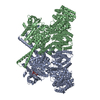
|
|---|---|
| 1 |
|
- Components
Components
| #1: Protein/peptide | Mass: 1362.438 Da / Num. of mol.: 2 / Source method: obtained synthetically / Details: Custom synthesized peptide / Source: (synth.)  Homo sapiens (human) / References: UniProt: P04637 Homo sapiens (human) / References: UniProt: P04637#2: Protein | Mass: 365005.562 Da / Num. of mol.: 2 / Mutation: Q2971A Source method: isolated from a genetically manipulated source Source: (gene. exp.)  Homo sapiens (human) / Gene: ATM / Cell (production host): Kidney (Embryonic) / Cell line (production host): Expi293F / Production host: Homo sapiens (human) / Gene: ATM / Cell (production host): Kidney (Embryonic) / Cell line (production host): Expi293F / Production host:  Homo sapiens (human) Homo sapiens (human)References: UniProt: Q13315, non-specific serine/threonine protein kinase #3: Chemical | #4: Chemical | #5: Chemical | Has ligand of interest | Y | |
|---|
-Experimental details
-Experiment
| Experiment | Method: ELECTRON MICROSCOPY |
|---|---|
| EM experiment | Aggregation state: PARTICLE / 3D reconstruction method: single particle reconstruction |
- Sample preparation
Sample preparation
| Component | Name: ATM(Q2971A) dimeric C-terminal region activated by H2O2 and bound to Mg AMP-PNP and p53 substrate peptide Type: COMPLEX Details: Only the C-terminal region of the ATM (Q2971A) dimer from local refinement is shown, with AMP-PNP and p53 substrate peptide bound in the structure. Please note, the whole dimer molecule is present in the sample. Entity ID: #1-#2 / Source: RECOMBINANT |
|---|---|
| Source (natural) | Organism:  Homo sapiens (human) Homo sapiens (human) |
| Source (recombinant) | Organism:  Homo sapiens (human) / Cell: Kidney (Embryonic) Homo sapiens (human) / Cell: Kidney (Embryonic) |
| Buffer solution | pH: 7.5 |
| Specimen | Embedding applied: NO / Shadowing applied: NO / Staining applied: NO / Vitrification applied: YES |
| Vitrification | Instrument: FEI VITROBOT MARK IV / Cryogen name: ETHANE |
- Electron microscopy imaging
Electron microscopy imaging
| Experimental equipment |  Model: Titan Krios / Image courtesy: FEI Company |
|---|---|
| Microscopy | Model: FEI TITAN KRIOS |
| Electron gun | Electron source:  FIELD EMISSION GUN / Accelerating voltage: 300 kV / Illumination mode: FLOOD BEAM FIELD EMISSION GUN / Accelerating voltage: 300 kV / Illumination mode: FLOOD BEAM |
| Electron lens | Mode: BRIGHT FIELD / Nominal magnification: 105000 X / Nominal defocus max: 3000 nm / Nominal defocus min: 1000 nm |
| Specimen holder | Specimen holder model: FEI TITAN KRIOS AUTOGRID HOLDER |
| Image recording | Electron dose: 39.5 e/Å2 / Film or detector model: GATAN K3 (6k x 4k) |
- Processing
Processing
| Software |
| ||||||||||||||||||||||||||||
|---|---|---|---|---|---|---|---|---|---|---|---|---|---|---|---|---|---|---|---|---|---|---|---|---|---|---|---|---|---|
| EM software |
| ||||||||||||||||||||||||||||
| CTF correction | Type: PHASE FLIPPING AND AMPLITUDE CORRECTION | ||||||||||||||||||||||||||||
| Symmetry | Point symmetry: C2 (2 fold cyclic) | ||||||||||||||||||||||||||||
| 3D reconstruction | Resolution: 3 Å / Resolution method: FSC 0.143 CUT-OFF / Num. of particles: 30707 / Symmetry type: POINT | ||||||||||||||||||||||||||||
| Atomic model building | PDB-ID: 7SIC Accession code: 7SIC / Source name: PDB / Type: experimental model | ||||||||||||||||||||||||||||
| Refinement | Cross valid method: NONE Stereochemistry target values: GeoStd + Monomer Library + CDL v1.2 | ||||||||||||||||||||||||||||
| Displacement parameters | Biso mean: 152.88 Å2 | ||||||||||||||||||||||||||||
| Refine LS restraints |
|
 Movie
Movie Controller
Controller





 PDBj
PDBj
